CEDIA Expo 2002
(Note: All prices in US dollars unless otherwise
noted.)
The members of the Custom Electronic
Design and Installation Association (CEDIA) gathered in Minnesota recently to check out
new products and trends in the business. Nearly 20,000 folks showed up at the Minneapolis
Convention Center from September 25 to 29 for CEDIA Expo 2002. The cold, light drizzle
that fell on attendees going to and from the center chilled their bones, but it didn't
dampen enthusiasm for the growing custom installation business. Inside the sprawling, airy
complex of steel and glass, members of the industry and media (the Expo wasn't open to the
general public) were treated to hundreds of exhibits of products, ranging from
loudspeakers of all sizes and shapes to CD players, DVD players, plasma TVs, home-lighting
systems, amplifiers, electronic blackjack tables, SACD players, flat cables, home-theater
furniture, and on and on. Let's take a look at some of what was offered for consideration.
Birth of a tweeter
Harman/Kardon introduced its new line of loudspeakers at
CEDIA Expo 2002. The company famous for its CD players and receivers, among other things,
has jumped into the speaker market as well.
Its new speakers include:
- HKB 4 -- Two-way bookshelf (.75" tweeter, 4"
woofer), $249/pair.
- HKB 6 -- Two-way bookshelf (.75" tweeter, 6"
woofer), $349/pair.
- HKTW 6 -- Two-way floorstanding (.75 tweeter, 6"
woofer), $249/each.
- HKC -- Two-way center-channel speaker (.75" tweeter,
dual 5" woofers), $249/each.
- HKSUB 12 -- Subwoofer (12" woofer, 150W built-in
amplifier), $399/each.
All of the H/K loudspeakers (except the HKSUB 12 subwoofer)
feature titanium-laminate-dome tweeters.
Harman/Kardon also introduced its CDR 26 at the CEDIA
convention. This CD recorder/player features MP3-disc playback, 4x-speed CD dubbing, and
direct digital-to-digital recording capability. That means you can take your DAT (Digital
Audio Tape recorder/player), for instance, and run it into the CDR 26, and make a
recording directly onto a CD with it. It also has a 24-bit DAC and a built-in sampling
rate converter (see our glossary for easy-to-understand definitions of "DAC,"
"DAT," "jitter," and lots of other audio terms). The CDR 26 has a
suggested retail price of $449.
No sticks, just Karats
German loudspeaker-maker Canton also had its Karat M10 DC
bookshelf speakers on display also. These two-way speakers go for $900 per pair and
feature an aluminum-manganese tweeter and a 6" front-mounted aluminum woofer (Canton
speakers typically have side-mounted woofers). These speakers are often used as surrounds
in a high-end home-theater system, but they might be worth exploring as high-quality,
compact stereo speakers as well.
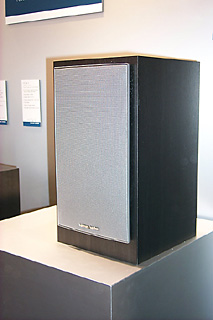
Harman Kardon |
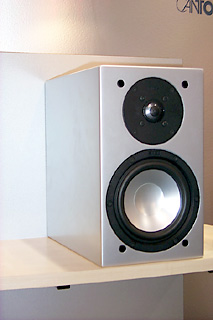
Canton |
Turn your head and KEF
If you're looking for speakers that'll make your friends
turn their heads, KEF's XQ One might do the trick. These three-way bass-reflex speakers
are compact (16.4"H x 9"W x 12.1"D), and stylish, featuring a tiny, chromed
ball sitting atop each cabinet. They're what KEF calls its "hypertweeter:" a
19mm titanium-dome tweeter that the company claims will disperse your high-end sounds over
a greater area, expanding the legendary "sweet spot." The KEF XQ One speakers
retail for $900 per pair.
Seeing sound
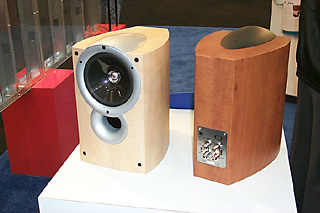
KEF
|
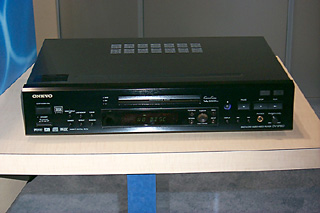
Onkyo
|
Though two-channel (stereo) systems were in
short supply at the convention, components that can comprise such a system, or enhance an
existing one, were in abundance. One such product is Onkyo's new DV-SP800 progressive-scan
DVD player. Of course it's not a traditional stereo-system piece, but traditions are made
to be broken and this new DVD/SACD/DVD-A player does it at an affordable price: $999.
Expect that price to drop in coming months as the competition over these universal players
heats up. The DV-SP800 also plays regular ol' CDs -- the standard now and for the
foreseeable future -- as well as MP3 CDs, CD-Rs, and CD-RWs. The THX Ultra-Certified
DV-SP800 also has 192kHz/24-bit digital-to-analog audio converters. Even if you don't want
to use its video capabilities, it's an audio product worth checking out next time you're
in an electronics store.
Getting turned Denon
Denon's reliable DRA-685 stereo receiver put in an
appearance at Expo 2002. For $499 you get multi-room capability, meaning that you can
listen to a CD in one room, for instance, while someone else listens to the radio in
another -- all powered by this one receiver. The DRA-685 puts out 100W of power per
channel into 8 ohms (20Hz to 20kHz, Total Harmonic Distortion is quoted at .05%).
Miller & Kreisel & K series
One of the most eye'n'ear-catching of the bookshelf
loudspeakers at the show were M&K's new K series speakers, led by the K-17 model. They
stand almost 13" high and have a flashy titanium finish and a 1" silk-dome
tweeter. Vital stats: Impedance is 4 ohms; frequency response is 80Hz to 20kHz (+/-2.5dB);
recommended power is 25W to 150W. Price: $299 each.
M&K also showed off its 850 system, said by the company
to be a step up from its acclaimed 750 package of speakers. While the entire 850 system is
going to be pretty expensive, a pair of the surrounds (LCR-650s) will be under $1000, and
judging by what I heard in a quickie audition at the CEDIA show, well worth it. Keep an
eye out for these.
Archetypal Paradigm fantasy
I came across a website the other day that claimed to be
selling a pair of Monitor 7 speakers from Canadian manufacturer Paradigm for $29. Since
that price is about 1/20th of what they usually go for, I bought several dozen as stocking
stuffers and gifts for casual acquaintances. (If you come across the same site, you'll
find that in reality the speakers go for about $600 per pair. The site’s price is
clearly a mistake.)
Regardless, most critics agree that Paradigm makes some
very good speakers. (Check out reviews of Paradigm's Monitor 5s, Atoms, and Active/40s). Paradigm's
$600 per pair Studio/20 speakers, shown off at the convention, are affordable and widely
acknowledged to give listeners about as much precision and punch as one can reasonably
expect at that price.
Paradigm also displayed its SA-10R a two-driver, two-way
in-ceiling speaker retailing for $500 per pair. The speaker features a 1" aluminum
high-frequency driver. Its frequency response is said to be +/-2dB from 60Hz to 22kHz.
For Alpha males and females
PSB's Alpha Bs are value-packed -- two-way bass-reflex
speakers with a frequency range said to be from 65Hz to 21kHz, with recommended power
handling from 10W to 90W, priced at $249 per pair. These third-generation Alphas have
.75" aluminum-dome tweeters and 5.25" polypropylene-cone woofers. They get rave
reviews everywhere, it seems, so if you're shopping for speakers, you might want to
audition a pair of these speakers designed by audio legend Paul Barton.
Tuning in Boston
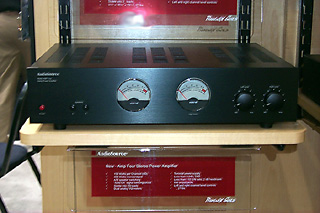
Audio Source
|
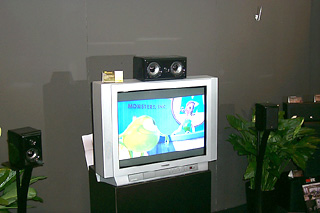
Acoustic Research
|
If you think it's odd that Boston Acoustics,
best known for its home and car speakers, is marketing the first radio in its 23-year
history, you're right. It is odd. But Boston Acoustics is one of those companies
that likes to throw the occasional curveball at the audio world and it did so with the
debut of its Recepter at CEDIA Expo 2002. The Recepter is a $200 AM/FM radio that might
well remind you of some Bose products (the Recepter has some patent-pending circuitry that
is said to deliver bass performance "out of proportion to its remarkably compact
size"). It's got two independent alarm clocks, unique circuitry to lock-in stations,
and 20 station presets.
Ample amps
Audio Source has been around for 27 years, making some
good, affordable gear. At this year's CEDIA Expo, they had their new Amp 100 and Amp 4 on
display. The 100 gives you 50Wpc into 8 ohms for $199.95, while the Four is a 150Wpc
stereo amp. It has dual analog VU meters, a toroidal power supply, A/B speaker switching,
auto-on signal-sensing circuitry, and specs claiming less than .04% THD -- all for
$399.95.
Research and development
Acoustic
Research's HC6 surround system was also on display. While it isn't brand new, the
system has gotten some positive attention in the A/V press over the past year or so. The
price has come down a bit since we last saw it: The suggested retail is now $699, down 100
bucks. The HC6 system includes four identical satellite speakers (5.25''H x 7.75''W x
6.75''D), with a claimed frequency response of 80Hz to 20kHz, 8-ohm nominal impedance, and
recommended power of 20W to 100W. The system also has a center-channel speaker (frequency
response is said to be 80Hz to 20kHz, +/-3dB) and subwoofer (28Hz to 150Hz, +/-3dB).
We're outta Minnesota, eh
That's it from Minneapolis and CEDIA Expo 2002. While the
conference certainly wasn't about two-channel systems, it was exciting to see so many
products applicable to stereo systems being introduced and re-introduced. No matter what
you might read elsewhere, two-channel music systems are far from dead. They're stayin'
alive, eh.
|